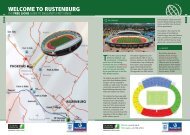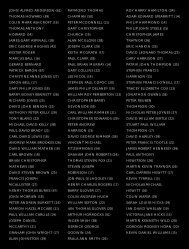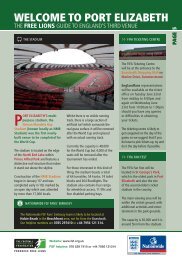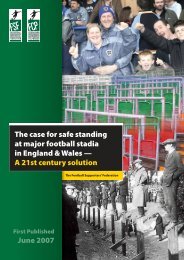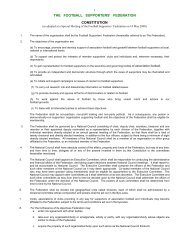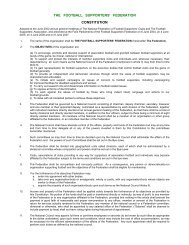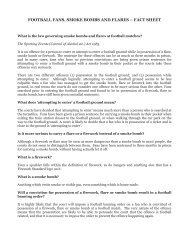Taylor Report - South Yorkshire Police
Taylor Report - South Yorkshire Police
Taylor Report - South Yorkshire Police
Create successful ePaper yourself
Turn your PDF publications into a flip-book with our unique Google optimized e-Paper software.
periods, the interval between applications to be as short as possible. A record has to be kept of the amount of<br />
deformation during each loading and of the percentage of recovery. If the recovery is less than 50% after the<br />
third application offeree, the barrier has failed the test. If recovery is between 50% and 75%, there must be a<br />
re-test. The question is: 50% or 75% of what? Is the recovery to be in relation to the position of the barrier<br />
before the first application offeree or before the third? If the former, a span of 124a recorded 53% at the 1988<br />
test and should have been re-tested. If the latter, it recorded 100% and passed. Unfortunately the Green Guide<br />
is unclear as to the correct interpretation. Dr Eastwood took the latter view and so passed the barrier. He<br />
justified his interpretation in evidence. He said failure to recover to the original position could be due to a<br />
"shake-down" effect related to some giving in the ashes under the concrete or to some other extraneous factor<br />
rather than to any defect in the material of the barrier itself.<br />
239. I think, after consulting Professor Maunder, that safety ought to have dictated recovery should be by<br />
reference to the position of the barrier before the first application of force. I accept, however, that the Green<br />
Guide is ambiguous and Dr Eastwood's interpretation is tenable. It has some support from the British<br />
Standards tests on steel structures. Clearly, however, for the future, the Green Guide should be clarified on this<br />
point.<br />
Corrosion<br />
240. Inspection of barrier 124a, and indeed other barriers at Hillsborough, by the HSE showed<br />
considerable corrosion of the metal at vulnerable points where water could accumulate. Dr Eastwood agreed<br />
that if a significant degree of corrosion was observed on visual inspection, a barrier should be condemned.<br />
241. The Green Guide does not specifically refer to corrosion. Paragraph 39 provides, inter alia:<br />
"Crush barriers and balustrades should be examined for deformation or any other overt signs of weakness".<br />
Paragraph 6 of Annex C provides:<br />
"If during any test, even though the barrier... satisfies the above loading requirements, doubt should arise<br />
for any reason (including such matters as cracking of the terracing or distortion of connections) as to the<br />
safety of the barrier... a detailed investigation should be carried out. Unless the results of this investigation<br />
remove the doubt as to safety of the barrier... (it) should be deemed to have failed the test".<br />
242. Since corrosion is a likely cause of deterioration, a revision of the Green Guide should make specific<br />
reference to it.<br />
Causation<br />
243. Tests done by the HSE suggest that although barrier 124a passed the loading test in 1988 and probably<br />
would have been able to sustain a force which did not exceed the test load, it was unable to resist the load<br />
imposed upon it by reason of the numbers in pen 3, the excessive gap in the barrier higher up the pen and the<br />
absence of barrier 144. Corrosion probably played a part, but the effective cause of the collapse was the<br />
excessive and unanticipated pressure to which the barrier was exposed.<br />
42



